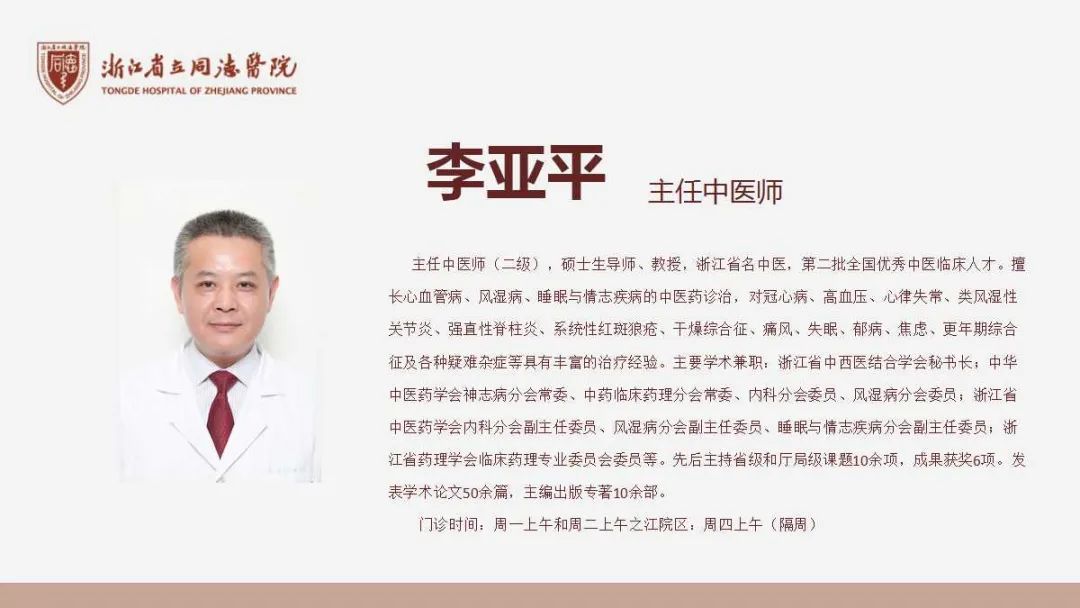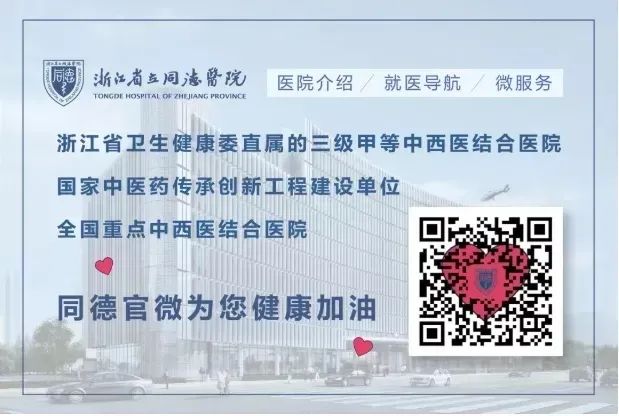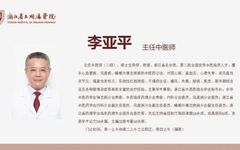
 Mr. Yang, 78 years old, has suffered from hypertension for over 20 years. He usually has a weak constitution, experiences shortness of breath and fatigue, and has a pale complexion. In winter, he is particularly sensitive to cold, with cold extremities. Two years ago, he underwent coronary artery stenting due to stenosis and blockage. After the surgery, he still experienced significant chest tightness, frequent dizziness, and worsening symptoms, becoming breathless and sweating profusely even after climbing to the second floor. Last year, accompanied by his family, Mr. Yang sought the help of Dr. Li Yaping, a renowned TCM physician in Zhejiang Province, hoping to use Traditional Chinese Medicine (TCM) to treat his condition. Dr. Li carefully inquired about his medical history, observed his complexion, and took his pulse, diagnosing him with Heart and Kidney Yang Deficiency (Xin Shen Yang Xu). He prescribed herbal medicine to tonify the heart and kidney and warm the Yang to open the meridians. After treatment, Mr. Yang’s condition stabilized, his blood pressure normalized, and symptoms like fatigue and shortness of breath improved. As winter approached, Dr. Li prescribed a medicinal paste for continued nourishment. This spring, Mr. Yang returned for a follow-up visit and happily reported: “Since taking the medicinal paste, my condition has been very stable, my complexion has improved, my energy has returned, and my shortness of breath and dizziness have resolved. I can climb stairs without difficulty. Most gratifyingly, my long-standing cold hands and feet during winter have also improved. I feel as if I have returned to my youth, which is wonderful.”Common cardiovascular diseases, such as hypertension, coronary heart disease, arrhythmia, viral myocarditis, cardiomyopathy, cardiac neurosis, rheumatic heart valve disease, chronic heart failure, as well as dyslipidemia and arteriosclerosis, can all be treated with medicinal pastes.Dr. Li Yaping believes that cardiovascular diseases often belong to the pattern of “deficiency at the root with excess at the branch”. Most cardiovascular diseases occur due to deficiency. The causes of cardiovascular diseases are influenced by various pathogenic factors that damage the heart and blood vessels, leading to an imbalance of Yin and Yang, with either excess or deficiency; or abnormal circulation of Qi and blood, resulting in obstruction of the blood vessels and poor blood flow. The core pathogenesis is due to deficiency leading to excess, with deficiency as the root and excess as the branch. The Huangdi Neijing states: “At the age of forty, the Yin Qi is already half gone.” This indicates that the internal cause of cardiovascular diseases is the deficiency of Zheng Qi (the body’s vital energy, including insufficient heart Qi and blood, and imbalance of Yin and Yang), which is the “root” of the disease. The six excesses, phlegm, Qi stagnation, and blood stasis are all “branches”. The TCM treatment philosophy is to “treat the root of the disease”; since the “root” of cardiovascular diseases is deficiency, including deficiency of heart Yin, Yang, Qi, and blood, it should be treated with tonification methods. Therefore, the main TCM treatment principle for cardiovascular diseases is “to focus on tonification, with circulation as a means, combining both tonification and circulation”. Thus, using medicinal pastes for tonification in cardiovascular diseases is both logical and appropriate.Some people worry that patients with cardiovascular diseases often have conditions such as “three highs” (hypertension, hyperlipidemia, and hyperglycemia), arteriosclerosis, poor circulation of Qi and blood, phlegm and stasis, obstruction of the heart vessels, and even vascular blockage. They fear that taking a nourishing and rich medicinal paste might raise blood pressure, destabilize blood lipids, or even worsen blood stasis in the heart vessels. However, this concern is completely unnecessary.
Mr. Yang, 78 years old, has suffered from hypertension for over 20 years. He usually has a weak constitution, experiences shortness of breath and fatigue, and has a pale complexion. In winter, he is particularly sensitive to cold, with cold extremities. Two years ago, he underwent coronary artery stenting due to stenosis and blockage. After the surgery, he still experienced significant chest tightness, frequent dizziness, and worsening symptoms, becoming breathless and sweating profusely even after climbing to the second floor. Last year, accompanied by his family, Mr. Yang sought the help of Dr. Li Yaping, a renowned TCM physician in Zhejiang Province, hoping to use Traditional Chinese Medicine (TCM) to treat his condition. Dr. Li carefully inquired about his medical history, observed his complexion, and took his pulse, diagnosing him with Heart and Kidney Yang Deficiency (Xin Shen Yang Xu). He prescribed herbal medicine to tonify the heart and kidney and warm the Yang to open the meridians. After treatment, Mr. Yang’s condition stabilized, his blood pressure normalized, and symptoms like fatigue and shortness of breath improved. As winter approached, Dr. Li prescribed a medicinal paste for continued nourishment. This spring, Mr. Yang returned for a follow-up visit and happily reported: “Since taking the medicinal paste, my condition has been very stable, my complexion has improved, my energy has returned, and my shortness of breath and dizziness have resolved. I can climb stairs without difficulty. Most gratifyingly, my long-standing cold hands and feet during winter have also improved. I feel as if I have returned to my youth, which is wonderful.”Common cardiovascular diseases, such as hypertension, coronary heart disease, arrhythmia, viral myocarditis, cardiomyopathy, cardiac neurosis, rheumatic heart valve disease, chronic heart failure, as well as dyslipidemia and arteriosclerosis, can all be treated with medicinal pastes.Dr. Li Yaping believes that cardiovascular diseases often belong to the pattern of “deficiency at the root with excess at the branch”. Most cardiovascular diseases occur due to deficiency. The causes of cardiovascular diseases are influenced by various pathogenic factors that damage the heart and blood vessels, leading to an imbalance of Yin and Yang, with either excess or deficiency; or abnormal circulation of Qi and blood, resulting in obstruction of the blood vessels and poor blood flow. The core pathogenesis is due to deficiency leading to excess, with deficiency as the root and excess as the branch. The Huangdi Neijing states: “At the age of forty, the Yin Qi is already half gone.” This indicates that the internal cause of cardiovascular diseases is the deficiency of Zheng Qi (the body’s vital energy, including insufficient heart Qi and blood, and imbalance of Yin and Yang), which is the “root” of the disease. The six excesses, phlegm, Qi stagnation, and blood stasis are all “branches”. The TCM treatment philosophy is to “treat the root of the disease”; since the “root” of cardiovascular diseases is deficiency, including deficiency of heart Yin, Yang, Qi, and blood, it should be treated with tonification methods. Therefore, the main TCM treatment principle for cardiovascular diseases is “to focus on tonification, with circulation as a means, combining both tonification and circulation”. Thus, using medicinal pastes for tonification in cardiovascular diseases is both logical and appropriate.Some people worry that patients with cardiovascular diseases often have conditions such as “three highs” (hypertension, hyperlipidemia, and hyperglycemia), arteriosclerosis, poor circulation of Qi and blood, phlegm and stasis, obstruction of the heart vessels, and even vascular blockage. They fear that taking a nourishing and rich medicinal paste might raise blood pressure, destabilize blood lipids, or even worsen blood stasis in the heart vessels. However, this concern is completely unnecessary.
01
What Preventive and Therapeutic Effects Do Medicinal Pastes Have for Cardiovascular Patients?
The application of medicinal pastes in the prevention and treatment of cardiovascular diseases is quite extensive.First, for prevention.For those in a state of “sub-health”, experiencing mental stress, overburdened heart and blood vessels, often feeling chest discomfort, having a dull complexion, or having blood pressure, blood lipids, and blood sugar levels at normal high values or borderline levels, using medicinal pastes can serve a preventive role before illness occurs.Second, for preventing disease progression.For those already suffering from various cardiovascular diseases, such as hypertension, hyperlipidemia, arteriosclerosis, coronary heart disease, viral myocarditis, arrhythmia, and rheumatic heart disease, using medicinal pastes can help support the vital energy, eliminate pathogenic factors, adjust functions, promote recovery, or prevent disease progression.Third, for preventing recurrence after recovery.Some cardiovascular diseases, after treatment, enter a recovery phase and require medicinal pastes for conditioning to promote recovery. It can be said that in most cases, cardiovascular diseases are suitable for using medicinal pastes for winter nourishment.
02
Principles for Using Medicinal Pastes in Cardiovascular Disease Patients
To effectively use medicinal pastes for treating cardiovascular diseases, the principles and characteristics of their application can be summarized as follows:First, adhere to the pathogenesis and differentiate syndromes.Differentiating syndromes and treating accordingly is the most fundamental principle of medicinal paste prescriptions. Physicians analyze the patient’s condition and constitution through observation, listening, questioning, and pulse-taking, integrating the four diagnostic methods to analyze the causes, mechanisms, and locations of the disease, considering the relationships between the Zheng (normal) and Xie (pathogenic), branch and root, deficiency and excess, to propose the treatment principles for the patient, determine specific treatment methods, and finally formulate the medicinal paste prescription. Of course, it is important to emphasize syndrome differentiation without neglecting the differentiation of disease and constitution. For patients with different diseases and constitutions, the treatment with medicinal pastes should adopt different methods.Second, grasp the pathogenesis, focusing on tonification while using circulation as a means, combining both tonification and circulation.Patients with cardiovascular diseases are mostly middle-aged and elderly, with deficiency as the root and excess as the branch. Cardiovascular diseases have a long course and are difficult to cure in a short time, often characterized by prolonged deficiency, involvement of the kidneys, involvement of the collaterals, stagnation due to prolonged illness, and phlegm generated from stagnation. Therefore, it is necessary to adhere to the principle of focusing on tonification while using circulation as a means, combining both tonification and circulation.Third, regulate Qi and blood, ensuring smooth circulation.Frequently use herbs that tonify heart Qi, along with herbs that promote Qi circulation, invigorate blood, and open the collaterals (such as insect herbs).Fourth, nourish Yin and Yang, aiming for balance.Reasonably select nourishing herbs, applying both cold and warm, to balance Yin and Yang. For patients with hypertension, nourishing Yin herbs such as Tie Pi Shi Hu (Iron Wire Dendrobium) and Tai Zi Shen (Pseudostellaria Root) are often chosen. For tonifying kidney Qi, herbs like Du Zhong (Eucommia Bark), Tu Si Zi (Dodder Seed), Rou Cong Rong (Cistanche), and Ba Ji Tian (Morinda Root) are selected, while caution is advised with warming and drying herbs like Fu Zi (Aconite) and Rou Gui (Cinnamon). Only with a balance of Yin and Yang can one avoid bias. Some individuals may experience heat when taking medicinal pastes, which could be due to not maintaining this balance.Fifth, combine movement and rest, paying attention to spleen function.The use of medicinal pastes for cardiovascular diseases emphasizes the combination of movement and rest, and the integration of tonification and circulation, achieving the goal of tonifying without stagnation and eliminating pathogenic factors while maintaining stability. The efficacy of medicinal pastes also relies on the healthy function of the spleen. After taking the paste, if the stomach feels comfortable and can digest and absorb, the tonification effect can be achieved. Therefore, in clinical prescriptions, it is essential to always consider the Qi of the spleen and stomach, which is referred to as tonification without neglecting the strengthening of the spleen to assist in transportation.For individuals with inherently weak spleen and stomach function, it is advisable to avoid overly rich tonifying herbs in the prescription. The selection of herbs should focus on those that warm the middle, promote spleen function, and aid digestion. Even for those with healthy spleen and stomach function, when tonifying deficiency, it is also necessary to include ingredients that strengthen the spleen and assist in transportation, such as Cang Zhu (Atractylodes), Bai Zhu (White Atractylodes), Chen Pi (Aged Tangerine Peel), Sha Ren (Amomum Fructus), and Zhi Qiao (Bitter Orange). Tonifying products tend to be more static, so it is beneficial to appropriately combine them with aromatic and moving ingredients to enhance their effects. This is known as the wonderful principle of “combining tonification and circulation, integrating movement and rest”.When formulating medicinal pastes, it is advisable to include ingredients that promote spleen function and enhance digestion, such as Sha Ren (Amomum Fructus), Ban Xia (Pinellia), Zhi Qiao (Bitter Orange), Fo Shou (Buddha’s Hand), Lv Mei Hua (Green Plum Flower), and Chao Mai Ya (Fried Barley Sprout), to awaken the spleen and open the appetite, transform phlegm, and promote Qi; using Jie Geng (Platycodon) and Zhi Qiao (Bitter Orange) to ensure the proper rise and fall of Qi; and combining Chen Pi (Aged Tangerine Peel), Shan Zha (Hawthorn), and Ji Jin (Chicken Gold) to aid digestion and resolve accumulation. For those with loose stools, herbs like Mu Xiang (Costus Root), Hua Jiao (Zanthoxylum), Shan Yao (Chinese Yam), Qian Shi (Euryale Seed), Lian Zi (Lotus Seed), and Bian Dou (Hyacinth Bean) can be used. Especially Cang Zhu (Atractylodes), which has a pungent and aromatic flavor, is a key herb for promoting spleen function. Adding it to many rich tonifying products can help eliminate the sticky nature of tonifying herbs, enhancing the spleen’s transport function.
03
Do Patients Taking Medicinal Pastes Need to Take Other Medications Simultaneously?
For healthy individuals or those in a sub-health state, taking medicinal pastes alone does not require other Chinese herbs or proprietary Chinese medicines.
For individuals recovering from illness, surgery, or childbirth, it is possible to take other Chinese herbs or proprietary Chinese medicines as needed while taking the paste.
Middle-aged and elderly individuals often suffer from multiple chronic diseases and need to take some medications regularly. For chronic disease patients undergoing treatment, it is generally not advisable to stop their regular medications while taking medicinal pastes. Cardiovascular disease patients typically do not need to stop their original treatment medications while taking the paste. If the condition stabilizes or is basically cured, some medications can be reduced or stopped under the guidance of a physician..
Expert Introduction



